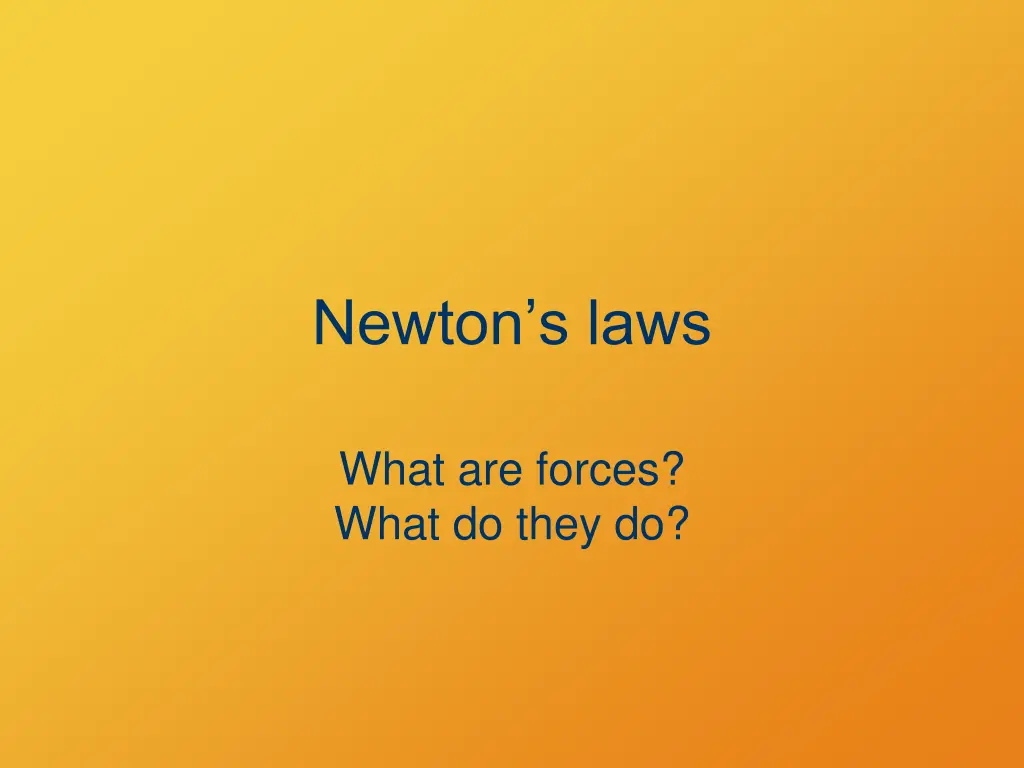
Understanding Newton's Laws of Motion and Forces
Explore the principles of Newton's laws of motion and forces, including the definition of forces, their effect on motion, the concept of net force, and Newton's first law. Delve into the natural tendencies of motion and Aristotle's views on object motion.
Download Presentation

Please find below an Image/Link to download the presentation.
The content on the website is provided AS IS for your information and personal use only. It may not be sold, licensed, or shared on other websites without obtaining consent from the author. If you encounter any issues during the download, it is possible that the publisher has removed the file from their server.
You are allowed to download the files provided on this website for personal or commercial use, subject to the condition that they are used lawfully. All files are the property of their respective owners.
The content on the website is provided AS IS for your information and personal use only. It may not be sold, licensed, or shared on other websites without obtaining consent from the author.
E N D
Presentation Transcript
Newtons laws What are forces? What do they do?
Whats the point? What makes things move, stop, or change direction? Are these even the right questions?
Group Work 1. What is a force? 2. Is a force a vector, a scalar, or something else? 3. What is the role of force in motion?
Force A push or pull Chapter 4
Force Forces are vectors Magnitude: How hard? How strong? Direction: Which way?
Net Force Forces acting on a body add as vectors. Forces can reinforce each other. Forces can oppose each other. Net force is the (vector) sum of all forces acting on a body. Net force can be zero: if no forces act (never happens) if forces cancel (add to 0)
Newtons First Law the law of inertia
Whats the point? What is the natural tendency of motion? What governs an object s motion?
Aristotles View Things tend to their natural place Fire and air: up Earth and water: down Heavens: perfect circles Exceptions: Violent motion requiring force
Newtons First Law An object s state of motion does not change unless a nonzero net force acts upon it. If at rest, it remains at rest. If moving, it continues straight at constant speed. Representation of Newton by William Blake, 1795
Does it Make Sense? Do you feel a force while cruising in a plane? A train? An automobile? If you were moving in a perfectly straight line at a constant velocity inside a closed box, could you tell?
What does Newtons first law mean? Being at rest is nothing special; it is just another value (zero) of constant velocity. rest constant velocities
What does Newtons first law mean? Aristotle s notions of natural position and violent motion are out Changing velocity, not position, requires intervention
Equivalent Statement Newton s first law: F = 0 a = 0 Zero net force means constant velocity Constant velocity means zero not force
Converse Equilibrium Rule: An object with a constant velocity experiences zero net force. That means that the forces acting on it all add to zero. A body with zero net force is in mechanical equilibrium.
Example Gravity pushes the anvil down. The table pushes the anvil up. zero net force
Newtons Second Law When net force isn t zero
Whats the point? How do forces affect motion quantitatively?
Experience Tells Us The greater the net force on an object, the more it accelerates. The greater the mass of an object, the harder it is to accelerate.
Newtons Second Law F a = m equivalently, F = ma a = acceleration F = net force m = mass
Quantify Force Unit of force: 1 newton (N) = force needed to accelerate 1 kg at 1 m/s2 How much is a newton? kg m s2 ? = ? ? = (1 kg) (1 m/s2) = 1
Net Force and Acceleration Always in the same direction! a = F/m m > 0 always
Group work 4. A 0.750-kg bowl of petunias falls at the rate of 9.8 m/s2. What is the net force acting on it? image stolen from Zell Wood on Tumblr
Force of weight ? = ? ? ? is local gravitational field At Earth s surface, ? 9.8 N/kg down magnitude varies slightly with location magnitude decreases with altitude direction toward center of the Earth
Newtons third law Nothing acts alone
Question If a 0.25-g insect collides with a 1250-kg compact car, which experiences the greatest (magnitude of) force in the collision? A. The insect. B. The car. C. It s a tie. D. Insufficient information to answer.
Newtons Third Law To every action there is an equal and opposite reaction. If object A exerts force F on object B, object B exerts force F on object A, along the same line of interaction. FA B = FB A
Bug + Windshield Small car: 1250 kg Large insect: 0.00025 kg From the same force, the bug accelerates a lot more!
Interaction Forces All forces are interaction forces! gravity wind jumping everything! This means: whenever something accelerates, something else accelerates in the opposite direction! Whoa!
Group work 5. A basket of peaches weighing 12.0 N sits on a table. exerts a downward force of 12.0 N on the basket. exerts an upward force of 12.0 N on the basket. The basket exerts a downward force of 12.0 N on . The basket exerts an upward force of 12.0 N on .
Group Question 6. Your educated mule argues that there is no point in pulling a cart, because the cart will pull back on him as hard as he pulls on it. What should you tell him? A. Oh, sorry, you re right. B. It won t, trust me. C. The cart s pull isn t the only force on you. D. It has to work. Newton must be wrong.
